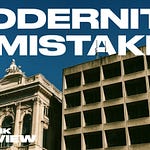Advertising has long been the backbone of media, but what if writers didn’t have to answer to advertisers at all? That question sparked the creation of Substack, a platform built around a simple but radical idea: give writers the tools to publish freely and let the readers decide what’s worth paying for.
In an interview with Freethink, Substack founders Chris Best, Hamish McKenzie, and Jairaj Sethi discuss the frustrations that led to their now-familiar model and reflect on what it means to build a business around free speech and trust. As journalists flee legacy institutions and audiences seek alternatives to outrage-fueled feeds, Substack has become both a beacon of independence and a lightning rod for controversy.
Timestamp
0:00 The attention economy and the media's dilemma
0:54 A new model: The birth of Substack
3:02 Making publishing viable again
4:33 Controversy and the culture war
6:10 The future of Substack and media innovation
Transcript
The below is a true verbatim transcript taken directly from the video. It captures the conversation exactly as it happened.
The attention economy and the media's dilemma
What is the media industry like? The way that I think about this is: the story of the internet. You're in an era where there's this tremendous market opportunity for attention. If you're making a company, don't worry about how it makes money, worry about grabbing your share of the attention. But what came out of that was business models that were based around aggregating attention as cheaply as possible, and then selling it off as a commodity to the highest bidders.
Commerce was not a core feature of the early internet, and to make money, media companies utilized a tried and true media model: Ads.
Writers go to work and they're forced to make listicles. They're not happy about it, and we're scrolling through our feeds and all this junk is there as well and we're not happy about it. It's like, why are we doing this?
But the more interesting question is: How could it be different? How could you change it?
A new model: The birth of Substack
Many in media are now exploring different approaches. The greatest value that Substack has brought to the world is that it offers a new model. The idea is simple: Instead of running ads against articles to make money, on Substack, readers pay writers directly for the content they write. But putting that idea into practice has been more controversial than you might think. Is Substack a threat to the old guard media and tech companies? Does it spur the dissemination of lies and hate? Or is it creating a more sustainable media ecosystem?
I'm really obsessed with Jane Jacobs for some reason. The Death and Life of Great American Cities, what it takes to make a great city, and all of the ways that you can hinder a city by messing with it in the wrong ways.
There was this first phase of the internet that was kind of an attention land grab. If you're old enough to remember, people used to get bored, where you'd be sitting there and you're like, I want something to do. I think that that ended up creating a bunch of perverse consequences. The things that maximally outrageous us or make us angry or afraid, those are the things that win in that ecosystem.
In 2017, Chris wrote a blog post detailing his frustrations with the media landscape. Before hitting publish, he sent a draft to his friend Hamish McKenzie, an old colleague and a journalist.
And it was him that I reached out to with this essay that I was writing that became the idea for Substack.
He said, “you're not as clever as you think you are with this. Just make sure you don't make a fool of yourself. Include a couple of paragraphs that suggest a better way of doing things.”
Out of Chris and Hamish's discussions came a manifesto titled A Better Future For News. The post took off, and Substack was born.
Making publishing viable again
The thing that is at the core of Substack really is an idea. It's a different deal. It's a different business model.
In practice, Substack provides an easy to use set of publishing tools for creators who can choose whether or not they want to charge for their work. If they do, the company takes 10%.
It's much easier for anyone, no matter who they are, where they came from, who their dad was, to start a media business. And it might not look like starting the New York Times, not at first, but it can be a newsletter or a podcast or a blog and you can make pocket money or you can make a full-time living or you can actually start making millions of dollars a year. All these cases are happening today on Substack.
Chris approached an old colleague, Jairaj Sethi, to help him build an early version of the platform.
“My exact words might have been, I can't think of a reason why this is dumb,” says Jairaj. “There are some things I don't know, like, would people pay for this? This is good for some people so it's worthwhile to build it.”
A lot of people were willing to pay writers for their work. Substack popularity grew so quickly that it attracted competition from other startups like Ghost and from social media heavyweights like Facebook and Twitter who attempted to clone some of Substack's features. Despite that, many writers have developed huge readerships on Substack. Other seasoned journalists have left their positions at legacy media organizations in order to write directly for readers.
Controversy and the culture war
But is an email newsletter really the solution for the media's troubles?
Some people have announced they’re going to be leaving Substack in protest of Substack's platforming of transphobes. Some have asked for diversity metrics and haven’t heard back. Others raise concerns about Holocaust deniers or overt racism publishing on Substack.
We knew from the start, we were making something that was kind of aimed at the heart of the culture war in some ways. Substack's approach to what it allows on the platform has been to intervene as little as possible. Besides cases like doxing or threats of violence, they've chosen not to intervene as a matter of principle. Best believes a free press, a flourishing, vibrant, intellectual culture is a prerequisite for a successful, free society.
It's the principle that protects voices at the margins. It's something that you have to stand for and defend. For us, free speech is a non-negotiable. It's table stakes to good discourse and to a good platform.
Some people are gonna subscribe to stuff that I think is awful or that I think is a waste of time, but we can still fulfill our mission by giving people that choice. It's not about getting you to read what I think you should read. It's about getting you to read what you think you should read.
Some of the other platforms have folded a little bit, and we've kind of stood our ground. If you've got a better way, show me the better way. I haven't seen it.
The future of Substack and media innovation
Will Substack change their stance on content moderation? Will the model evolve to incorporate ads to sustain the business? Will a competitor like Ghost or Twitter exceed Substack's reach, or has the company's approach to monetization created a new business model for a fledgling industry?
Only time will tell.
I don't think that we're like the magic wand that fixes all of the media problems we wish were fixed, but I think there's a tremendous amount that we can contribute.
Even if Substack goes away but the model endures, then Substack has made a really big contribution to the world. Now we've got hope, and that matters a lot.
How many writers can make a living doing this? That's the real journey that we're on. How far does this go? I feel like we're in the early part of that journey.










Share this post